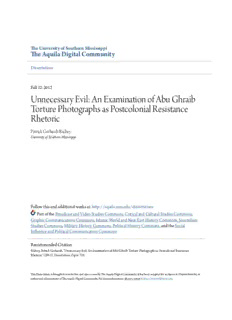
Unnecessary Evil: An Examination of Abu Ghraib Torture Photographs as Postcolonial Resistance ... PDF
Preview Unnecessary Evil: An Examination of Abu Ghraib Torture Photographs as Postcolonial Resistance ...
TThhee UUnniivveerrssiittyy ooff SSoouutthheerrnn MMiissssiissssiippppii TThhee AAqquuiillaa DDiiggiittaall CCoommmmuunniittyy Dissertations Fall 12-2012 UUnnnneecceessssaarryy EEvviill:: AAnn EExxaammiinnaattiioonn ooff AAbbuu GGhhrraaiibb TToorrttuurree PPhhoottooggrraapphhss aass PPoossttccoolloonniiaall RReessiissttaannccee RRhheettoorriicc Patrick Gerhardt Richey University of Southern Mississippi Follow this and additional works at: https://aquila.usm.edu/dissertations Part of the Broadcast and Video Studies Commons, Critical and Cultural Studies Commons, Graphic Communications Commons, Islamic World and Near East History Commons, Journalism Studies Commons, Military History Commons, Political History Commons, and the Social Influence and Political Communication Commons RReeccoommmmeennddeedd CCiittaattiioonn Richey, Patrick Gerhardt, "Unnecessary Evil: An Examination of Abu Ghraib Torture Photographs as Postcolonial Resistance Rhetoric" (2012). Dissertations. 720. https://aquila.usm.edu/dissertations/720 This Dissertation is brought to you for free and open access by The Aquila Digital Community. It has been accepted for inclusion in Dissertations by an authorized administrator of The Aquila Digital Community. For more information, please contact [email protected]. The University of Southern Mississippi UNNECESSARY EVIL: AN EXAMINATION OF ABU GHRAIB TORTURE PHOTOGRAPHS AS POSTCOLONIAL RESISTANCE RHETORIC by Patrick Gerhardt Richey Abstract of a Dissertation Submitted to the Graduate School of The University of Southern Mississippi in Partial Fulfillment of the Requirements for the Degree of Doctor of Philosophy December 2012 ABSTRACT UNNECESSARY EVIL: AN EXAMINATION OF THE ABU GHRAIB TORTURE PHOTOGRAPHS AS POSTCOLONIAL RESISTANCE RHETORIC By Patrick Gerhardt Richey December 2012 The purpose of this dissertation is to examine the rhetorical nature of visual artifacts in a postcolonial context. In order to examine the nature of visual artifacts as a form of resistance against static ideologies and prevailing power structures, the author uses both media and cultural artifacts created in response to photographs taken of abused prisoners at Iraq’s Abu Ghraib Correctional Facility. The dissertation adds to scholarly knowledge of communication by addressing the intersections of iconographic visual communication and postcolonial resistance rhetoric. The dissertation provides a scholarly review of the Abu Ghraib prison scandal, as well as of literature explicating visual rhetoric theories. The dissertation likewise proposes a research question and constructs a theoretical lens that challenges Hariman and Lucaites’s (2002, 2003) concepts regarding iconography. The dissertation investigates concepts of postcolonialism and Islam in light of a static American ideology. Finally, the dissertation investigates how political cartoonists and artists hijacked Abu Ghraib images in order to resist American ideology. ii COPYRIGHT BY PATRICK GERHARDT RICHEY 2012 The University of Southern Mississippi UNNECESSARY EVIL: AN EXAMINATION OF ABU GHRAIB TORTURE PHOTOGRAPHS AS POSTCOLONIAL RESISTANCE RHETORIC by Patrick Gerhardt Richey A Dissertation Submitted to the Graduate School of The University of Southern Mississippi in Partial Fulfillment of the Requirements for the Degree of Doctor of Philosophy Approved: _Keith Erickson___________________ Director _Richard Conville_________________ _John Meyer_____________________ _Steven Venette__________________ _Wendy Atkins-Sayre______________ _Susan A. Siltanen_________________ Dean of the Graduate School December 2012 DEDICATION Dedicated to Rebecca, Abigail, and Robert; the greatest gift of all: a family. iii ACKNOWLEDGMENTS The road to completing this dissertation began in December 2002 during U.S. preparations for the invasion of Iraq. It is perhaps fitting that I finished the dissertation almost exactly a decade later. The year I spent on the ground in Iraq was a blur of heat, misery, joy, hope, life, and death that made little sense at the time and, to a certain extent, still does not. This dissertation is a byproduct of that conflict. It has helped me to answer some of the questions that still haunt me and the lives of those forever changed by what happened “over there,” including Robert Sweeney III who never came home. The road was not a road I travelled alone. First and foremost, I would like to thank my wife, Becky, who for over ten years stood by my side when things were bleak. She was always there to lend a helping hand, whether it was proof reading my drafts or offering advice. I would like to thank my dissertation committee, Dr. Richard Conville, Dr. John Meyer, Dr. Steven Venette, and Dr. Wendy Atkins-Sayre for their insight, comments, guidance, and friendship. I would especially like to thank my dissertation chair, Dr. Keith Erickson, who was willing to put up with my shenanigans, hair brained ideas, and work with the general disarray that constitutes a dissertation. Without his tutelage, mentorship, and patience, this dissertation may never have been completed. I also wish to thank Mary Jo McKay for all her words of encouragement. I thank as well Dr. Casey Maugh for her insight on visual rhetoric and tips for organizing my thoughts. I wish to thank as well Dr. Larry C. James (Col. US Army, Ret.) for his reflections as lead psychologist sent to Abu Ghraib after the scandal broke. I also thank Dr. Andrew Wiest for his guidance and advice. I also thank Dr. Nagwa Megahed and Dr. Ben Hardman for their reviews of the postcolonial chapter and their advice on iv Islamic culture and history. I would like to thank René Fleischbein, Stephan Lack, Tahseen Shams, and Fadwa Silmi for their help translating Arabic. Thanks are likewise extended to the estates of Gerald Laing, Susan Crile, and Shahin Aldhahir for giving me permission to reproduce their art. Finally I would like to thank Java Werks, Starbucks, and Just Love Coffee for the hundreds of gallons of java and quiet workspace necessary to complete the dissertation. v TABLE OF CONTENTS ABSTRACT……………………………………………………………………...………....ii DEDICATION……………………………………………………………………..………iii ACKNOWLEDGMENTS……………..…………...……………………………...……….iv LIST OF ILLUSTRATIONS…………………………………………………..…...…….viii CHAPTER I. THE ABU GHRAIB PRISON SCANDAL ................................................. 1 Introduction Abu Ghraib Historical Overview The Photographs Abu Ghraib Articles Abu Ghraib Theses and Dissertations II. ABU GHRAIB PHOTOGRAPHS - MORE THAN MEETS THE EYE: AN INTRODUCTION TO VISUAL RHETORIC AND REVIEW OF LITERATURE ........................................................................................... 36 Review of Literature: Visualizing the Rhetorical Act Abu Ghraib Photographs as Iconography III. JUSTIFICATION AND METHODOLOGY ...………...…………..…... 58 Justification Research Question Methodology IV. US VESUS THEM?: POST-COLONIAL RHETORIC REVIEW OF LITERATURE ........................................................................................... 69 White Man’s Burden Westoxification or Occidentosis Post-colonialism Static America Ideologies vi
Description: